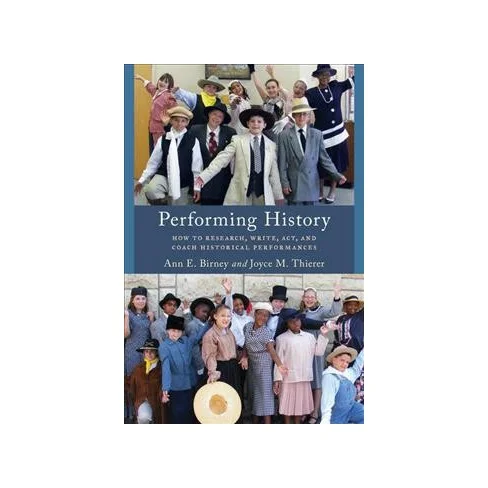Performing History: How to Research, Write, Act, and Coach Historical Performances.
By: Birney, Ann E. and Joyce M. Thierer. Lanham, MD:
Published: Rowan and Littlefield, 2018.
As historical performers, Ann E. Birney and Joyce M. Thierer characterize their work as a “mission,” and emphasize their “responsibility” to share the stories of historical figures whose lives have traditionally been ignored or overlooked by historians (xv). Birney and Thierer perform in a troupe called Ride into History, which was established in 1989, and focus on introducing female historical figures to audiences that range from grade school-aged children to senior citizens. Birney and Thierer are passionate about their work, and through their discussions of historical performances seek to redefine and expand the traditional definition of ‘historian’ to include actors, storytellers, and small business owners who work outside of the academy. Crucially, they also underscore the importance of historical performance as a way to remind audiences of the impacts of women and people of color throughout history.
In Performing History, Birney and Thierer are primarily concerned with sharing their experiences and knowledge as historical performers. Three of the chapters (one, five, and seven) are aimed at organizations that deliver historical performances, providing them with practical instructions for managing their business and producing entertaining and educational demonstrations. In these chapters, Birney and Thierer discuss the nuts and bolts of historical performances, from establishing a troupe to choosing a partner with whom to perform and manage a business. They also provide information about the details that should be included in performance contracts, how best to organize performance spaces, and how to deal with any performance-related problems that arise. The authors also inform prospective performers about the time commitment needed to create performances and the importance of delivering meaningful presentations that connect with audiences. Throughout, Birney and Thierer include personal stories and anecdotes about each of these topics.
The other four chapters in the book are directed at historical performers, and provide guidance on building compelling characters that will engage a variety of audiences. Importantly, the authors encourage performers to identify and conduct themselves as professional historians. For Birney and Thierer, this means carrying out extensive research into primary and secondary sources when developing their characters, engaging with archivists and librarians, investing the necessary time to understand the historical figures they plan to embody, and developing stories about them that will resonate with diverse audiences. In terms of their actual performances, the authors emphasize preparation, practice, and showing respect both for the historical figure being portrayed and one’s audience. As in other chapters, Birney and Thierer share their experiences in this regard, and relay details of their depictions of figures including Calamity Jane, Amelia Earhart, and Rachel Carson to further illustrate their points to the reader.
Birney and Thierer also write extensively on the importance of engaging young people in historical performances and interpretations, and outline strategies for developing\\ youth performance camps and classes for younger students. The authors advocate “sharing the mantle of authority” with young performers by involving them in all aspects of historical performances, from choosing their characters and conducting research, to encouraging their participation in team production meetings (104). These activities, according to Birney and Thierer, teach children communication skills, build their confidence, and create a connection between young performers, their community, and the past. They provide instructions for interacting with young performers, and describe how to prepare for and mange a historical performance camp. Birney and Thierer describe this latter endeavor in specific terms: they list the best snacks to provide camp attendees, describe how camp meeting spaces should be organized, and provide sample registration forms, codes of conduct, and evaluations to be handed out at the end of the camp. Throughout this section, the authors also convey their experiences managing different types of youth performance camps, and share the testimonials of students who participated in and enjoyed these events.
Birney and Thierer’s desire to encourage people to engage in historical performances of all types is evident throughout the book, both in their enthusiastic descriptions of their work and in the practical advice they offer to individuals considering similar careers. They provide an extensive index intended to help potential performers in this regard, and share a variety of useful insights. Given their emphasis on working with children, the majority of items in the index focus on documents potentially useful to those interested in running youth performance camps. Birney and Thierer provide a timetable for operationalizing a camp, list daily responsibilities and timelines for camp activities, and share application and registration forms, as well as several other relevant documents. They also provide a potential list of figures that could serve as characters for historical performers to portray, as well as guiding questions about these figures’ lives and short descriptions of their historical significance. This index will undoubtedly be useful to historians venturing into this area of their field.
Performing History demystifies the art of historical performance and demonstrates the important role historians play outside of traditional academic settings. Birney and Thierer successfully show how their work compliments history as taught in classrooms and museums by engaging their audiences in a way that makes them feel as if they are part of and connected with historical figures and events. Graduates of public history programs will find this text useful, as it outlines a career path that includes research, writing, travel, and creative expression for historians interested in a career outside of the academy. Through their vivid descriptions and detailed guidance, Birney and Thierer will likely inspire new generations of historical performers to connect with audiences and share their love of history beyond the classroom.
